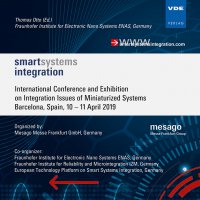Joining two worlds – hybrid integration of silicon based electronics and printed functionalities
Konferenz: Smart Systems Integration - 13th International Conference & Exhibition on Integration Issues of Miniaturized Systems
10.04.2019 - 11.04.2019 in Barcelona, Spain
Tagungsband: Smart Systems Integration
Seiten: 8Sprache: EnglischTyp: PDF
Persönliche VDE-Mitglieder erhalten auf diesen Artikel 10% Rabatt
Autoren:
Roscher, Frank; Thalheim, Robert; Seifert, Tobias; Paul, Soumya-Deep; Zichner, Ralf; Wiemer, Maik; Otto, Thomas (Fraunhofer Institute for Electronic Nanosystems, Chemnitz, Germany)
Inhalt:
The combination of digital printing and laser technologies allows to create individualized series products in a resource-efficient and cost-saving manner, even down to manufacturing single unique items. Using Ink-Jet, Aerosol-Jet, spraying or dispensing technologies passive substrate materials like metal sheets, polymer sheets or foils, injection molded parts or even formed metal 3D shapes could be functionalized with electrical conductive paths, thin insulation layers or even printed sensor features. Combining those functionalized substrates with highly integrated silicon or ceramic based electronics, sensors and actuators enables hybrid electrical systems that profit by the 3D capability of the additive digital technologies and the reliability and functionality of MEMS and semiconductors. Within this work we are exploring deposition technologies to fabricate conductive and insulating features on unconventional substrate materials as well as solder or epoxy based die attach technologies to mount standard SMD LED components, SMD Pin Headers, SMD resistors and ceramic piezo transducers upon printed conductive tracks. Standard conductive epoxy and Indium based low temperature solders have been tested to enable electrical and mechanical interconnects between the substrate and the SMD components.


